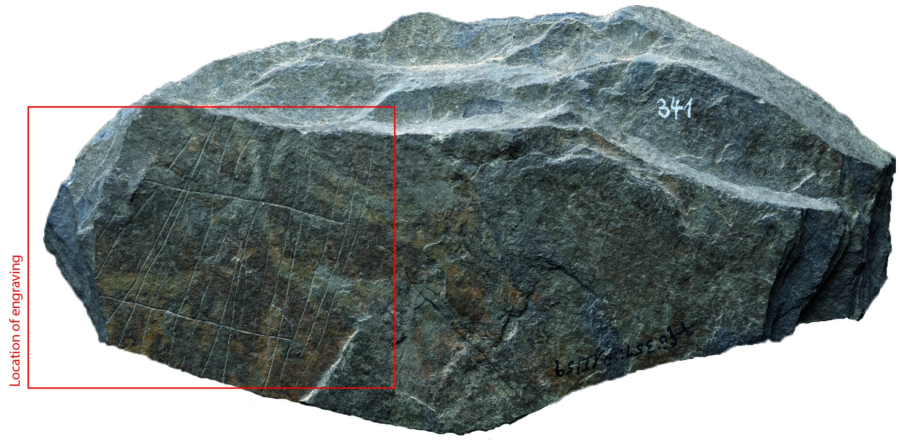The engravings from the Ice Age site of Gönnersdorf in Germany show fish in nets or traps, offering hints about how people fished thousands of years ago.

Leibniz-Zentrum für ArchäologieThese etchings of fish are just the latest exciting discoveries made at the Gönnersdorf site.
Some 15,800 years ago, an Ice Age civilization thrived in present-day Germany. At a site in Gönnersdorf, they built dwellings, produced objects like weapons and jewelry, and documented the world around them in schist engravings. Researchers studying these engravings have just found the oldest known depictions of fishing ever.
The engravings tell a fascinating story about Ice Age people and add to our understanding of what life was like thousands of years ago at Gönnersdorf.
The Fishing Engravings From Gönnersdorf

Robitaille, J., Meyering, E., Gaudzinski-Windheuser, S., Pettitt, P., Jöris, O., & Kentridge, R.Using more advanced technology, researchers were able to re-evaluate engravings found at the site, which is how they came across images of fish held in nets or traps.
According to a new study published in PLOS ONE, the Ice Age site at Gönnersdorf — first discovered in 1968 — is home to “406 engraved schist plaquettes.” Though these engravings have been “extensively studied” before, more advanced technology has allowed researchers to take a deeper look.
“The plaquettes from Gönnersdorf are covered with engravings, but previous analysis had focused primarily on representations of animals and figures,” study author Jerome Robitaille told All That’s Interesting in an email.
He continued: “To gain a deeper understanding of the plaquettes, I have been using Reflectance Transformation Imaging (RTI). This technology has proven invaluable for identifying and studying small engravings… It allows for a much more accurate visualization of the plaquettes, enhancing our observations beyond those of earlier studies.”
Using RTI, Robitaille and his team were able to “re-evaluate” the plaquettes and identify “nuanced depictions of fishing practices previously unrecorded for the Upper Palaeolithic.” Specifically, they identified fish and “grid motifs” which appear to be a deliberate portrayal of “the use of fishing nets.”

Robitaille, J., Meyering, E., Gaudzinski-Windheuser, S., Pettitt, P., Jöris, O., & Kentridge, R.These “nuanced depictions of fishing practices” are the oldest known illustrations of fishing ever found.
“I was very surprised,” Robitaille commented to All That’s Interesting. “Previous research had focused only on the animals and figures, with little attention paid to the smaller areas where the fish and net are visible.”
According to Robitaille, this suggests that fishing “played a more vital role” in Ice Age society than previously thought “both as a subsistence strategy and as a cultural activity.” What’s more, the depiction of fish within a grid pattern suggests an “artistic focus” on the “act of fishing,” indicating that ancient people saw fishing as a “structured, social, and possibly seasonal activity.”
The Ice Age site at Gönnersdorf has offered other valuable insights over the years as well. Researchers have found hundreds of other intricate schist engravings at the site, as well as evidence of the former settlement and plenty of artifacts like jewels, weapons, tools, and more.
Gönnersdorf, A Thriving Ice Age Site

Landschafts MuseumHow the Ice Age settlement at Gönnersdorf may have once appeared.
Gönnersdorf was first discovered in 1968. A remarkable Ice Age site, the former settlement is well preserved because of a layer of pumice that fell on the area following an eruption at the Laacher See volcanic caldera.
Since then, researchers have discovered evidence of human dwellings, more than 81,000 stone artifacts, figurines, tools, weapons, jewelry, items made from ivory and bone, and 406 engravings.
These fascinating schist engravings depict a variety of images carved by Paleolithic people thousands of years ago. They show wild horses, woolly rhinos, reindeer, and mammoths, as well as hundreds of “schematic, headless, and highly-stylized human female[s].” In the latter scenes, the women are seen meeting, gathering, and perhaps dancing.
As such, the schist engravings showing fish — the earliest such images ever documented — add to our understanding of this Ice Age camp in Germany. Almost 16,000 years ago, people there participated in a number of activities. And more significantly, they took the time to document them, offering us a window into their life as it unfolded during the Late Upper Paleolithic period.
Robitaille believes that the schist engravings can do much more than that. He’s currently working on a project to further examine the plaquettes in order to determine their “laterality.” That is, whether they were made by a left-handed or right handed person. As Robitaille told All That’s Interesting, this study of the engravings “may also help determine how many artists were involved in creating the plaquettes.”
After reading about the oldest known depictions of fishing ever found, look through this list of the most unbelievable prehistoric animals to ever walk the Earth. Or, learn about the coelacanth, the prehistoric fish that scientists thought went extinct 60 million years ago — until one was spotted in the 1980s.





